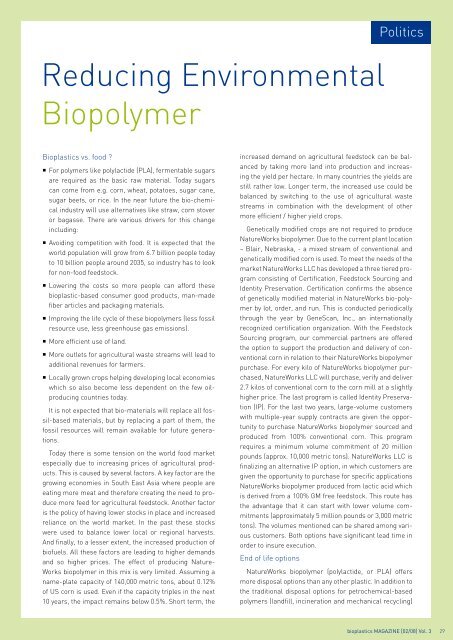02 | 2008
Create successful ePaper yourself
Turn your PDF publications into a flip-book with our unique Google optimized e-Paper software.
Politics<br />
Reducing Environmental<br />
Biopolymer<br />
Bioplastics vs. food ?<br />
• For polymers like polylactide (PLA), fermentable sugars<br />
are required as the basic raw material. Today sugars<br />
can come from e.g. corn, wheat, potatoes, sugar cane,<br />
sugar beets, or rice. In the near future the bio-chemical<br />
industry will use alternatives like straw, corn stover<br />
or bagasse. There are various drivers for this change<br />
including:<br />
• Avoiding competition with food. It is expected that the<br />
world population will grow from 6.7 billion people today<br />
to 10 billion people around 2035, so industry has to look<br />
for non-food feedstock.<br />
• Lowering the costs so more people can afford these<br />
bioplastic-based consumer good products, man-made<br />
fiber articles and packaging materials.<br />
• Improving the life cycle of these biopolymers (less fossil<br />
resource use, less greenhouse gas emissions).<br />
• More efficient use of land.<br />
• More outlets for agricultural waste streams will lead to<br />
additional revenues for farmers.<br />
• Locally grown crops helping developing local economies<br />
which so also become less dependent on the few oilproducing<br />
countries today.<br />
It is not expected that bio-materials will replace all fossil-based<br />
materials, but by replacing a part of them, the<br />
fossil resources will remain available for future generations.<br />
Today there is some tension on the world food market<br />
especially due to increasing prices of agricultural products.<br />
This is caused by several factors. A key factor are the<br />
growing economies in South East Asia where people are<br />
eating more meat and therefore creating the need to produce<br />
more feed for agricultural feedstock. Another factor<br />
is the policy of having lower stocks in place and increased<br />
reliance on the world market. In the past these stocks<br />
were used to balance lower local or regional harvests.<br />
And finally, to a lesser extent, the increased production of<br />
biofuels. All these factors are leading to higher demands<br />
and so higher prices. The effect of producing Nature-<br />
Works biopolymer in this mix is very limited. Assuming a<br />
name-plate capacity of 140,000 metric tons, about 0.12%<br />
of US corn is used. Even if the capacity triples in the next<br />
10 years, the impact remains below 0.5%. Short term, the<br />
increased demand on agricultural feedstock can be balanced<br />
by taking more land into production and increasing<br />
the yield per hectare. In many countries the yields are<br />
still rather low. Longer term, the increased use could be<br />
balanced by switching to the use of agricultural waste<br />
streams in combination with the development of other<br />
more efficient / higher yield crops.<br />
Genetically modified crops are not required to produce<br />
NatureWorks biopolymer. Due to the current plant location<br />
– Blair, Nebraska, - a mixed stream of conventional and<br />
genetically modified corn is used. To meet the needs of the<br />
market NatureWorks LLC has developed a three tiered program<br />
consisting of Certification, Feedstock Sourcing and<br />
Identity Preservation. Certification confirms the absence<br />
of genetically modified material in NatureWorks bio-polymer<br />
by lot, order, and run. This is conducted periodically<br />
through the year by GeneScan, Inc., an internationally<br />
recognized certification organization. With the Feedstock<br />
Sourcing program, our commercial partners are offered<br />
the option to support the production and delivery of conventional<br />
corn in relation to their NatureWorks biopolymer<br />
purchase. For every kilo of NatureWorks biopolymer purchased,<br />
NatureWorks LLC will purchase, verify and deliver<br />
2.7 kilos of conventional corn to the corn mill at a slightly<br />
higher price. The last program is called Identity Preservation<br />
(IP). For the last two years, large-volume customers<br />
with multiple-year supply contracts are given the opportunity<br />
to purchase NatureWorks biopolymer sourced and<br />
produced from 100% conventional corn. This program<br />
requires a minimum volume commitment of 20 million<br />
pounds (approx. 10,000 metric tons). NatureWorks LLC is<br />
finalizing an alternative IP option, in which customers are<br />
given the opportunity to purchase for specific applications<br />
NatureWorks biopolymer produced from lactic acid which<br />
is derived from a 100% GM free feedstock. This route has<br />
the advantage that it can start with lower volume commitments<br />
(approximately 5 million pounds or 3,000 metric<br />
tons). The volumes mentioned can be shared among various<br />
customers. Both options have significant lead time in<br />
order to insure execution.<br />
End of life options<br />
NatureWorks biopolymer (polylactide, or PLA) offers<br />
more disposal options than any other plastic. In addition to<br />
the traditional disposal options for petrochemical-based<br />
polymers (landfill, incineration and mechanical recycling)<br />
bioplastics MAGAZINE [<strong>02</strong>/08] Vol. 3 29


















